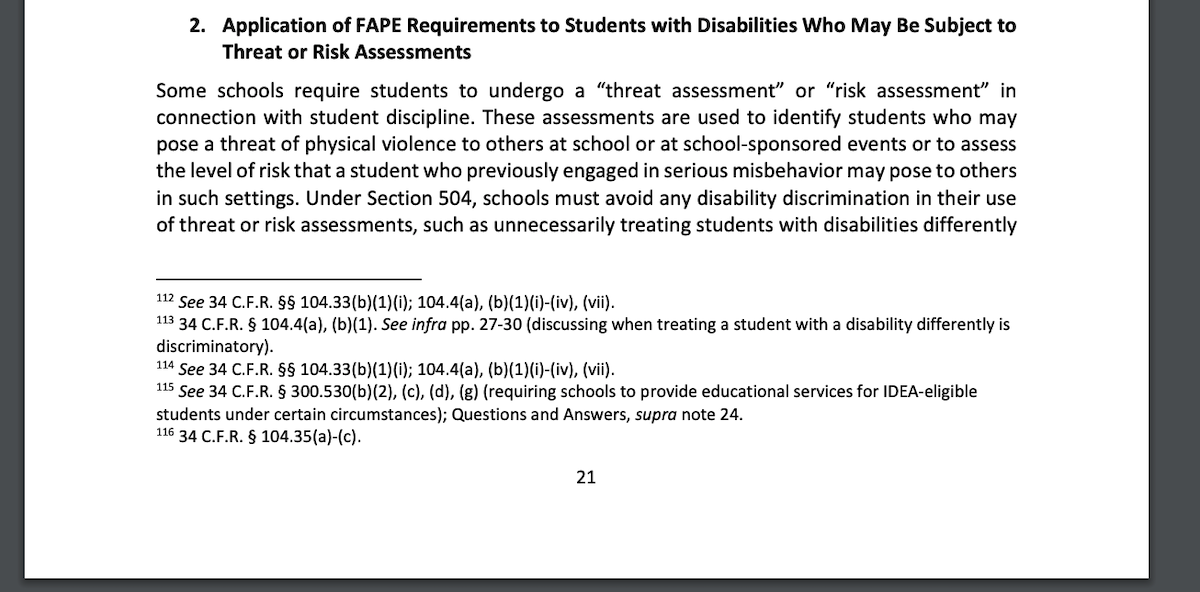When a child has significant behavior challenges at school, school districts sometimes tell families to obtain a threat or risk assessment of their child through the mental health system before their child can attend or return to school. These assessments can result in inpatient evaluations.
The July 2022 guidance from the Department of Education’s Office for Civil Rights (OCR) and Office of Special Education and Rehabilitative Services (OSERS) clarifies that school districts cannot use these assessments to discriminate against students with disabilities. Districts should ensure that those conducting the assessments know of students’ disabilities and coordinate assessments with students’ 504 plans and Individualized Education Programs (IEPs). The guidance also emphasizes the importance of training and explains that disability-related requirements do not interfere with a school’s ability to address a situation that threatens safety. These are direct quotes about threat/risk assessments from the guidance document:
“Schools have a responsibility not to discriminate in, among others, the following activities related to student discipline: questioning a student with a disability and investigating allegations of a violation of school rules; issuing tickets, citations, and fines for violations of school rules, such as truancy; using surveillance technologies; conducting searches of students with disabilities and their property; making referrals of students with disabilities to law enforcement, including referrals that result in school-related arrests; and initiating or carrying out threat or risk assessments of students with disabilities.”
“Some schools require students to undergo a ‘threat assessment’ or ‘risk assessment’ in connection with student discipline. These assessments are used to identify students who may pose a threat of physical violence to others at school or at school-sponsored events or to assess the level of risk that a student who previously engaged in serious misbehavior may pose to others in such settings. Under Section 504, schools must avoid any disability discrimination in their use of threat or risk assessments, such as unnecessarily treating students with disabilities differently from other students, and must safeguard a student with a disability’s FAPE rights throughout any threat or risk assessment process. Schools can do so by ensuring that school personnel who are involved in screening for and conducting threat or risk assessments for a student with a disability are aware that the student has a disability and are sufficiently knowledgeable about the school’s FAPE responsibilities so that they can coordinate with the student’s Section 504 team. A school district whose threat or risk assessment team does not coordinate with the Section 504 team of a student with a disability could risk violating the student’s FAPE rights (emphasis added).”
“Training may also be invaluable to school personnel who are responsible for making threat or risk assessments. Appropriate training could help such individuals distinguish incidents that are best resolved by involving a crisis intervention professional and providing other reasonable modifications to help the student de-escalate from incidents that otherwise could pose a serious and immediate safety threat requiring removal from school (emphasis added).”
“Coordination with the Section 504 team prior to completing the threat or risk assessment determination could result in additional or different behavioral supports to mitigate or eliminate the threat or risk. For example, the Section 504 team can provide valuable information about: the nature of the student’s disability-based behaviors and common triggers; whether the student has been receiving behavioral supports, and, if so, the effectiveness of those supports; and specific supports and services that may be able to mitigate or eliminate the risk of harm without requiring exclusion from school. Even if a student is removed from school following a threat or risk assessment, the school must ensure that the student continues to receive the services required for FAPE and that the student is afforded any applicable procedural rights, including, as needed, by notifying and consulting the student’s Section 504 team (emphasis added).”
“Section 504 FAPE requirements do not interfere with a school’s ability to address those extraordinary situations in which a student’s behavior, including disability-based behavior, is an immediate threat to their own or others’ safety. For example, nothing in Section 504’s FAPE requirements prohibits schools from contacting mental health crisis intervention specialists or law enforcement under such extraordinary circumstances, even if the result is that those professionals remove the student from school. Additionally, OCR recognizes that, in emergency circumstances, based on exigency and safety, a school may seek to impose an immediate short-term disciplinary removal of a student with a disability because the student’s behavior presents a serious and immediate threat to the safety of the student or of others that cannot be mitigated by other means. Any OCR investigation would review the specific facts to determine whether the school’s conduct was reasonably necessary to ensure safety, including under circumstances where an immediate removal would result in a pattern of removals (emphasis added).”
If your child’s school asks you about obtaining a threat or risk assessment for your child, and you want to ensure the school doesn’t discriminate against your child and that the school coordinates the assessment with your child’s 504 Plan or IEP, we are happy to support you. (We can also help you obtain an evaluation for a 504 Plan or IEP if your child does not have either.) Call us at 601-355-0915.

